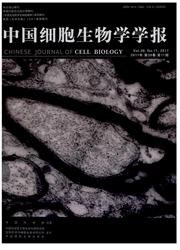

 中文摘要:
中文摘要:
血栓性疾病是临床常见疾病,涉及全身各脏器,其发生与血管损伤、血液成分变化及局部血流淤滞等改变有关。P-选择素作为血小板/内皮细胞活化标志及黏附受体,参与血栓形成起始过程,并是连接炎症与血栓的重要介质和靶分子。为此,进行了以P-选择素为靶标的分子磁共振成像(magnetic resonance imaging,MRI)在血栓早期诊断中的应用研究。利用自制的抗P-选择素单抗(PsL-EGFmAb),制备了具有P-选择素靶特异性的MR对比剂(Gd-DTPA)n-BSA-PsL-EGFmAb,并在体外MR成像基础上,进行了犬静脉血栓模型活体观察。结果显示,该对比剂可明显增强体外模拟血小板血栓和全血血栓的显像信号。进一步发现,相应于P-选择素在建模后即刻犬受损静脉血管内膜及形成的血栓部位表达,模型犬在损伤局部注射对比剂后30min,MR成像即显示高于周围肌肉显影的血管信号,1h可见附壁血栓增强信号,至3h随血栓形成增大而持续强化,显示了与P-选择素表达一致的信号强化效果。另从股静脉损伤部位的远心端注射对比剂后30min至1h,也显示上述成像效果,2h至4h血栓信号强度由明显上升渐见趋缓,延迟24h信号强度减弱。此外,该对比剂对实验犬的生命体征及心、肺、肝、肾等理化指标均无明显影响。研究结果提示,研制的MR对比剂对P-选择素具有靶向特异性,可活体内早期定位显像及反映血栓形成状态,且对机体重要脏器功能无影响,这为早期诊断血栓性疾病提供了一种可行的方法。
 英文摘要:
英文摘要:
Thrombotic disease is a clinically common disease involving various organs that is associated with vessel injury, blood constituent alteration and the local stasis of blood flow. P-selectin, an activation marker and adhesive receptor of platelets and endothelial cells, takes part in the initiation of thrombosis, and links inflammation with thrombosis as an important mediator and target molecule. Accordingly, we tried to use molecular magnetic resonance imaging (MRI) with a P-selectin targeted contrast agent to diagnose thrombosis in the early phase. The P- selectin-targeted contrast agent was developed by conjugating anti-P-selectin lectin-EGF domain monoclonal anti- body (PsL-EGFmAb) which was prepared by our lab. We investigated the potential of this contrast agent using in vitro molecular imaging experiment as well as in vivo experiment in a dog model of venous thrombosis. The resultsindicated that the imaging signals were enhanced by the P-selectin-targeted contrast agent both in platelet-thrombo- sis and whole blood-thrombosis in vitro. Further study showed that, P-selectin was expressed immediately in tunica intima of injured vein and subsequently in thrombus after the model established. Correspondingly, mural thrombus showed higher signal visualization than surrounding muscle 30 min after contrast agent injection. These enhanced signals exhibited P-selectin specificity and persisted from the initiation of intima lesions to 3 h after development of thrombosis. The same results were derived from 30 min to 4 h after contrast agent being injected in distal to heart part of the injured vessel, and the signal decreased 24 h later. Moreover, the contrast agent did not affect the vital signs of the dog and the heart, lung, liver and kidney functions remained normal after contrast administration. In conclusion, our results suggested that the new prepared MR contrast agent exhibited high specific binding to P- selectin, and can be used to locate thrombus and reflect the status of thrombosis in the early stag
 同期刊论文项目
同期刊论文项目
 同项目期刊论文
同项目期刊论文
 期刊信息
期刊信息
